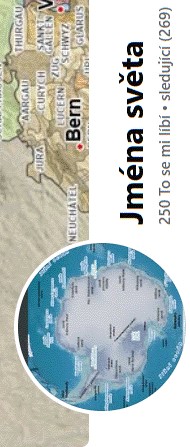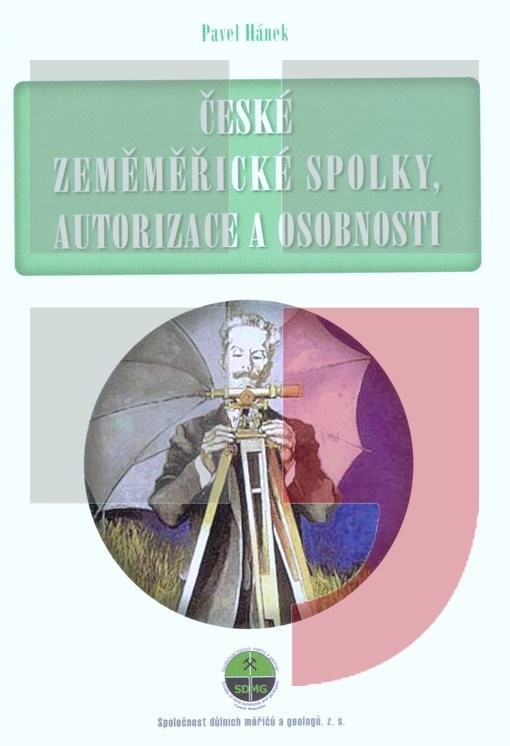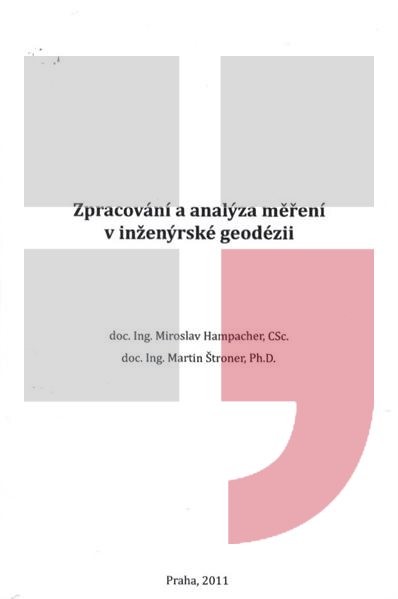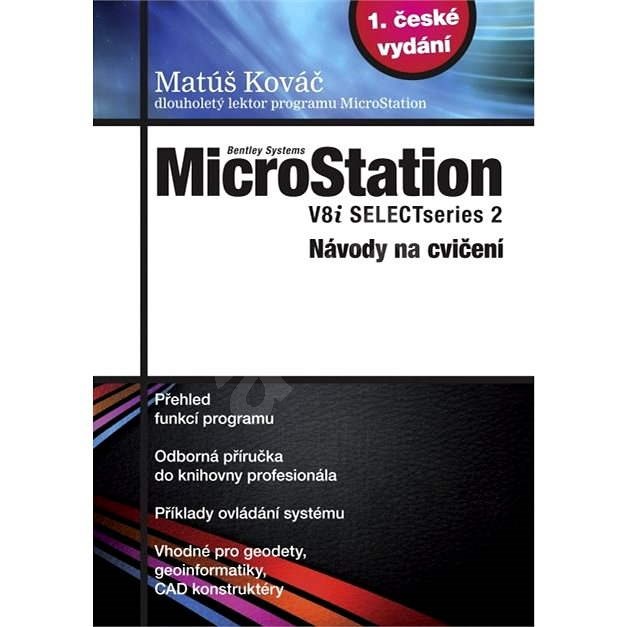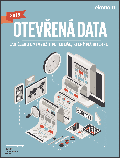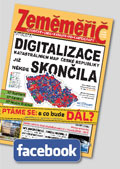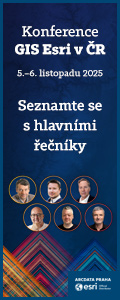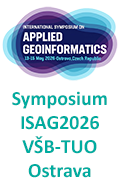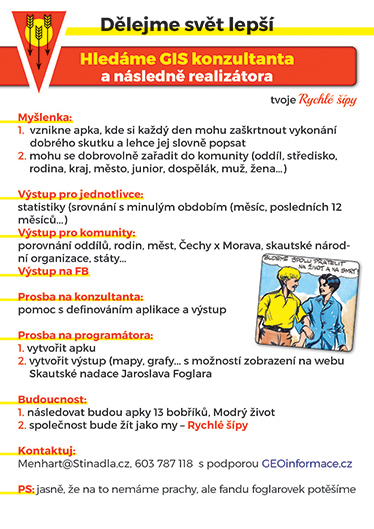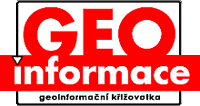zprávy
zdroje zpráv:20161004-seznam úředně opráv. zeměměřických inženýrů
4.10.2016 10:51 ČÚZK - předpisy a opatření Aktualizovaný seznam úředně oprávněných zeměměřických inženýrů zde.20161004-seznam úředně opráv. zeměměřických inženýrů
4.10.2016 10:51 ČÚZK /Aktuality-resort/2016/20161004-seznam-uredne-oprav-zememerickych-inzenyrDoprovodný program konference
4.10.2016 8:35 ARCDATAPokud jste se zatím nepřihlásili na letošní Konferenci GIS Esri v ČR, do konce týdne ještě máte možnost přihlásit se s uplatněním slevy na vstupném.
Hlavní program konference nabídne více než 20 hodin přednášek a workshopů, vedle toho se můžete těšit i na bohatý doprovodný program. Připravujeme pro vás například:
- krátké tematické workshopy přímo na stánku technické podpory,
- velké množství map,
- interaktivní prezentace internetových aplikací,
- výstavu soutěžních posterů a soutěž v poznávání družicových snímků,
- mobilní soupravu hydrometeorologického zabezpečení Armády ČR
- a mnoho dalšího.
Přihlaste se proto nejpozději do tohoto pátku 7. 10. a využijte svoji slevu z registračního poplatku.
INSPIRE stahovací služba WFS pro téma Dopravní sítě-lanová dráha (TN_CABLE)
4.10.2016 2:00 Cenia - Katalog metadat ČR - INSPIRE INSPIRE stahovací služba WFS pro téma Dopravní sítě-lanová dráha(TN_CABLE) je služba umožňující registrovaným uživatelům opakované stahování dat pomocí technologie WFS 2.0.0. Stahovací služba poskytuje harmonizovaná data INSPIRE tématu Dopravní sítě-lanová dráha(TN_CABLE) odpovídající INSPIRE xml schématu ve verzi 4.0. Data jsou poskytována ve formátu GML 3.2.1. a v souřadnicovém systému ETRS89/TM33 stanoveném INSPIRE pro zobrazení dat velkých měřítek. Tato datová sada dopravních sítí České republiky má proto jednotnou podobu s ostatními daty vytvářenými pro toto INSPIRE téma v rámci celé Evropy. Základem poskytované datové sady je Základní báze geografických dat České republiky (ZABAGED®). Služba splňuje technické pokyny pro INSPIRE stahovací služby verze 3.1 a zároveň splňuje standard OGC WFS 2.0.0.INSPIRE téma Adresy (AD)
4.10.2016 2:00 Cenia - Katalog metadat ČR - INSPIRE Data odpovídají směrnici INSPIRE pro téma adresy (AD). Vychází především z projektu RÚIAN (Registr územní identifikace, adres a nemovitostí), který je součástí základních registrů České Republiky a obsahuje informace o územní identifikaci, adresách a nemovitostech. Data publikovaná v rámci INSPIRE obsahují pouze adresní místa a jejich komponenty, kterými jsou stát, obec, část obce, městský obvod v Praze (MOP), městký obvod/městská část (MO/MČ), ulice a pošta a to na území celé České Republiky. Obsahují rozvněž geometrii, která určuje definiční bod adresního místa. V datové sadě nění uvedeno 2,55%, t.j. 74096 adresních míst (k 03. 10. 2016), protože neobsahují definiční bod, podle kterého by je bylo možné prostorově určit. Více v zákoně č. 111/2009 Sb., o základních registrech a ve vyhlášce č. 359/2011 Sb., o základním registru územní identifikace, adres a nemovitostí v platných zněních a INSPIRE Data Specification on Addresses v 3.0.1 z 26.4.2010.Centrální režimová databáze množství povrchových vod
4.10.2016 2:00 Cenia - Katalog metadat ČR - INSPIRE Za kalendářní rok 2014 byly do databáze uloženy vodní stavy a průtoky z 520 vodoměrných stanic, teplota vody ze 170 stanic a plaveniny ze 40 stanic. Více než 90% měření se provádí pomocí automatických stanic, a to buď smístním záznamem nebo s dálkovým přenosem. Pozorované vodní stavy se převádějí na průtoky pomocí měrných křivek, které se stanovují na základě hydrometrických měření. Do databáze se ukládají verifikované okamžité, průměrné hodinové a průměrné denní vodní stavy; průměrné hodinové a průměrné denní průtoky; okamžité měsíční kulminační průtoky. U teplot vody se ukládají ranní měřené teploty nebo kontinuálně měřené okamžité a průměrné denní hodnoty. U plavenin se jedná o okamžité a průměrné denní koncentrace, v závislosti na typu měření. Dále se ukládají hydrometrická měření, měrné křivky průtoků, příčné profily a popisnéúdaje vodoměrných stanic. U hraničních profilů se data průtoků odsouhlasují se sousedním státem.Datové řady jsou uloženy za celé období pozorování jednotlivých stanic, přičemž nejdelší řada průměrných denních průtoků je pro stanici Děčín na Labi od roku 1888.CRDPZV - centrální režimová databáze podzemních vod
4.10.2016 2:00 Cenia - Katalog metadat ČR - INSPIRE V roce 2014 byla do CRDPZV uložena data z 1812 objektů podzemních vod - stavy hladin z 1487 vrtů a vydatnosti z 325 pramenů. U vybraných pramenů se měří i ukládá teplota podzemní vody. Většina objektů je osazena automatickými stanicemi s místním záznamem nebo s přenosem dat, které měří 1x denně. Některé prameny ještě sledují dobrovolní pozorovatelé s četností měření 1x týdně a to ve středu. Většina dat je uložena od roku 1971 s četností měření 1x týdně. V 90-tých letech začala první pozorování pomocí automatických stanic s četností měření 1x denně. Nejvíce nových objektů bylo vybudováno v rámci projektu ISPA a zprovozněno v roce 2007. Ukládají se vodní stavy, vydatnosti, teploty, kontrolní měření a popisné údaje objektů.INSPIRE stahovací služba WFS pro téma Vodstvo (HY)
4.10.2016 2:00 Cenia - Katalog metadat ČR - INSPIRE INSPIRE stahovací služba WFS pro téma Vodstvo (HY) je služba umožňující registrovaným uživatelům opakované stahování dat pomocí technologie WFS 2.0.0. Stahovací služba poskytuje harmonizovaná data INSPIRE tématu Vodstvo (HY) odpovídající INSPIRE xml schématu ve verzi 4.0. Data jsou poskytována ve formátu GML 3.2.1. a v souřadnicovém systému ETRS89/TM33 stanoveném INSPIRE pro zobrazení dat velkých měřítek.Tato datová sada vodstva České republiky má proto jednotnou podobu s ostatními daty vytvářenými pro toto INSPIRE téma v rámci celé Evropy. Základem poskytované datové sady je Základní báze geografických dat České republiky (ZABAGED®). V současné době jsou poskytována data pro aplikační schéma pro fyzické vody. Služba splňuje technické pokyny pro INSPIRE stahovací služby verze 3.1 a zároveň splňuje standard OGC WFS 2.0.0.INSPIRE téma Budovy (BU)
4.10.2016 2:00 Cenia - Katalog metadat ČR - INSPIRE Data odpovídají směrnici INSPIRE pro téma budovy (BU). Data pochází částečně z projektu RÚIAN (Registr územní identifikace, adres a nemovitostí), který je součástí základních registrů České Republiky a obsahuje informace o územní identifikaci, adresách a nemovitostech, a částečně z ISKN (Informační systém katastru nemovistostí). Zdrojem informací o budovách v ISKN je objekt Stavba, v RÚIAN je to Stavební objekt. Většina Staveb je zároveň Stavebními objekty, ale jsou případy, kdy tomu tak není. Kromě Budov datová sada obsahuje i části budov, které jsou pro potřeby INSPIRE vyjádřeny vchody z RÚIAN. Vchody obsahují informace o počtu podlaží, technickoekonomických atributech apod. Datová sada pokrývá celé území české republiky. V datové sadě není uvedeno 2,09%, t.j. 87882 budov (k 03. 10. 2016), protože neobsahují definiční bod ani polygon. Více v zákoně č. 111/2009 Sb., o základních registrech, ve vyhlášce č. 359/2011 Sb., o základním registru územní identifikace, adres a nemovitostí v platných zněních, v zákoně 256/2013 Sb., o katastru nemovitostí, v katastrální vyhlášce č. 357/2013 Sb. v platném znění a INSPIRE Data Specification on Buildings v 3.0 z 13.12.2013.INSPIRE stahovací služba WFS pro téma Dopravní sítě-silniční doprava (TN_ROAD)
4.10.2016 2:00 Cenia - Katalog metadat ČR - INSPIRE INSPIRE stahovací služba WFS pro téma Dopravní sítě-silniční doprava (TN_ROAD) je služba umožňující registrovaným uživatelům opakované stahování dat pomocí technologie WFS 2.0.0. Stahovací služba poskytuje harmonizovaná data INSPIRE tématu Dopravní sítě-silniční doprava (TN_ROAD) odpovídající INSPIRE xml schématu ve verzi 4.0. Data jsou poskytována ve formátu GML 3.2.1. a v souřadnicovém systému ETRS89/TM33 stanoveném INSPIRE pro zobrazení dat velkých měřítek. Tato datová sada dopravních sítí České republiky má proto jednotnou podobu s ostatními daty vytvářenými pro toto INSPIRE téma v rámci celé Evropy. Základem poskytované datové sady je Základní báze geografických dat České republiky (ZABAGED®). Služba splňuje technické pokyny pro INSPIRE stahovací služby verze 3.1 a zároveň splňuje standard OGC WFS 2.0.0.INSPIRE stahovací služba WFS pro téma Dopravní sítě-železniční doprava (TN_RAIL)
4.10.2016 2:00 Cenia - Katalog metadat ČR - INSPIRE INSPIRE stahovací služba WFS pro téma Dopravní sítě-železniční doprava (TN_RAIL) je služba umožňující registrovaným uživatelům opakované stahování dat pomocí technologie WFS 2.0.0. Stahovací služba poskytuje harmonizovaná data INSPIRE tématu Dopravní sítě-železniční doprava (TN_RAIL) odpovídající INSPIRE xml schématu ve verzi 4.0. Data jsou poskytována ve formátu GML 3.2.1. a v souřadnicovém systému ETRS89/TM33 stanoveném INSPIRE pro zobrazení dat velkých měřítek. Tato datová sada dopravních sítí České republiky má proto jednotnou podobu s ostatními daty vytvářenými pro toto INSPIRE téma v rámci celé Evropy. Základem poskytované datové sady je Základní báze geografických dat České republiky (ZABAGED®). Služba splňuje technické pokyny pro INSPIRE stahovací služby verze 3.1 a zároveň splňuje standard OGC WFS 2.0.0.INSPIRE stahovací služba WFS pro téma Dopravní sítě-vodní doprava (TN_WATER)
4.10.2016 2:00 Cenia - Katalog metadat ČR - INSPIRE INSPIRE stahovací služba WFS pro téma Dopravní sítě-vodní doprava (TN_WATER) je služba umožňující registrovaným uživatelům opakované stahování dat pomocí technologie WFS 2.0.0. Stahovací služba poskytuje harmonizovaná data INSPIRE tématu Dopravní sítě-vodní doprava (TN_WATER) odpovídající INSPIRE xml schématu ve verzi 4.0. Data jsou poskytována ve formátu GML 3.2.1. a v souřadnicovém systému ETRS89/TM33 stanoveném INSPIRE pro zobrazení dat velkých měřítek. Tato datová sada dopravních sítí České republiky má proto jednotnou podobu s ostatními daty vytvářenými pro toto INSPIRE téma v rámci celé Evropy. Základem poskytované datové sady je Základní báze geografických dat České republiky (ZABAGED®). Služba splňuje technické pokyny pro INSPIRE stahovací služby verze 3.1 a zároveň splňuje standard OGC WFS 2.0.0.INSPIRE stahovací služba WFS pro téma Dopravní sítě-letecká doprava (TN_AIR)
4.10.2016 2:00 Cenia - Katalog metadat ČR - INSPIRE INSPIRE stahovací služba WFS pro téma Dopravní sítě-letecká doprava (TN_AIR) je služba umožňující registrovaným uživatelům opakované stahování dat pomocí technologie WFS 2.0.0. Stahovací služba poskytuje harmonizovaná data INSPIRE tématu Dopravní sítě-letecká doprava (TN_AIR) odpovídající INSPIRE xml schématu ve verzi 4.0. Data jsou poskytována ve formátu GML 3.2.1. a v souřadnicovém systému ETRS89/TM33 stanoveném INSPIRE pro zobrazení dat velkých měřítek. Tato datová sada dopravních sítí České republiky má proto jednotnou podobu s ostatními daty vytvářenými pro toto INSPIRE téma v rámci celé Evropy. Základem poskytované datové sady je Základní báze geografických dat České republiky (ZABAGED®). Služba splňuje technické pokyny pro INSPIRE stahovací služby verze 3.1 a zároveň splňuje standard OGC WFS 2.0.0.INSPIRE stahovací služba WFS pro téma Zeměpisná jména (GN)
4.10.2016 2:00 Cenia - Katalog metadat ČR - INSPIRE INSPIRE stahovací služba WFS pro téma Zeměpisná jména (GN) je služba umožňující registrovaným uživatelům opakované stahování dat pomocí technologie WFS 2.0.0. Stahovací služba poskytuje harmonizovaná data INSPIRE tématu Zeměpisná jména (GN) odpovídající INSPIRE xml schématu ve verzi 4.0. Data jsou poskytována ve formátu GML 3.2.1. a v souřadnicovém systému ETRS89/TM33 stanoveném INSPIRE pro zobrazení dat velkých měřítek. Tato datová sada geografických jmen České republiky má proto jednotnou podobu s ostatními daty vytvářenými pro toto INSPIRE téma v rámci celé Evropy. Základem poskytované datové sady je databáze geografických jmen České republiky Geonames, ke které jsou doplněna jména objektů, která jsou obsažena v Základní bázi geografických dat České republiky (ZABAGED®), ale nejsou součástí Geonames (jména ulic a náměstí, dopravních uzlů a chráněných území). Služba splňuje technické pokyny pro INSPIRE stahovací služby verze 3.1 a zároveň splňuje standard OGC WFS 2.0.0.INSPIRE téma Parcely (CP)
4.10.2016 2:00 Cenia - Katalog metadat ČR - INSPIRE Data odpovídají směrnici INSPIRE pro téma katastrální parcely (CP). Vychází z katastrální mapy, která je závazným státním mapovým dílem velkého měřítka, obsahuje body polohového bodového pole, polohopis a popis a může mít formu digitální mapy, analogové mapy nebo digitalizované mapy. Data publikovaná v rámci INSPIRE obsahují pouze katastrální území (pro celou Českou Republiku) a parcely a jejich hranice z území, kde je digitální mapa (k 03. 10. 2016 je to 85,74% území České republiky, t.j. 67 621,11km2). Více katastrální zákon 256/2013 Sb., katastrální vyhláška č.357/2013 Sb. v platném znění a INSPIRE Data Specification on Cadastral Parcels v 3.0.1.Státní pozemkový úřad spolupracuje se správci vodních toků na řešení nedostatku vody
4.10.2016 0:00 Státní pozemkový úřad Praha, 4. října 2016 – Ústřední ředitelka Státního pozemkového úřadu Svatava Maradová dnes podepsala spolu s generálními řediteli státních podniků Povodí Labe a Povodí Odry Mariánem Šebestou a Jiřím Pagáčem dohodu o vzájemné spolupráci. Obdobná dohoda se státním podnikem Povodí Moravy byla podepsána 27. září 2016.Referent/referentka oddělení privatizace a převodů, Krajský pozemkový úřad pro Karlovarský kraj
4.10.2016 0:00 Státní pozemkový úřad Státní pozemkový úřad přijme zaměstnance na pozici referent/referentka oddělení privatizace a převodů, Krajský pozemkový úřad pro Karlovarský kraj.Den s INSPIRE - Pozvánka
3.10.2016 21:07 Zeměměřič Seminář se uskuteční dne 11. 11. 2016 na Novotného lávce v Praze.Magnetic oceans and electric Earth
3.10.2016 18:30 ESA Observing the Earth
Oceans might not be thought of as magnetic, but they make a tiny contribution to our planet’s protective magnetic shield. Remarkably, ESA’s Swarm satellites have not only measured this extremely faint field, but have also led to new discoveries about the electrical nature of inner Earth.
20161003-vyšší verze schémat XML
3.10.2016 14:00 ČÚZK - předpisy a opatření ČÚZK přešel na vyšší verzi schémat XML (XSD 4.0) při poskytování INSPIRE datových sad a služeb. Více zde.20161003-vyšší verze schémat XML
3.10.2016 14:00 ČÚZK - předpisy a opatřeníČÚZK přešel na vyšší verzi schémat XML (XSD 4.0) při poskytování INSPIRE datových sad a služeb. Více zde.
20161003-vyšší verze schémat XML
3.10.2016 14:00 ČÚZK /Aktuality-resort/20161003-vyssi-verze-schemat-XML20161003-vyšší verze schémat XML
3.10.2016 14:00 ČÚZK /Aktuality-resort/2016/20161003-vyssi-verze-schemat-XML20161003-vyšší verze schémat XML
3.10.2016 14:00 ČÚZK - předpisy a opatření ČÚZK přešel na vyšší verzi schémat XML (XSD 4.0) při poskytování INSPIRE datových sad a služeb. Více zde.Earth from Space
3.10.2016 14:00 ESA Observing the Earth
Join us Tuesday, 4 October, at 14:00 CEST as four climate change and urban development experts join the show to discuss how satellite data can be used to promote sustainable cities
odborný referent v oddělení obnovy katastrálního operátu č. 3 na Technické sekci
3.10.2016 13:45 ČÚZK - předpisy a opatření Katastrální úřad pro Jihomoravský krajvypisuje výběrové řízení na místo
odborný referent v oddělení obnovy katastrálního operátu č. 3 na Technické sekci
odborný referent v oddělení obnovy katastrálního operátu č. 3 na Technické sekci
3.10.2016 13:45 ČÚZK - volná místa Katastrální úřad pro Jihomoravský kraj, vypisuje výběrové řízení na místo odborný referent v oddělení obnovy katastrálního operátu č. 3 na Technické sekciodborný referent v oddělení obnovy katastrálního operátu č. 3 na Technické sekci
3.10.2016 13:45 ČÚZK /Urady/Katastralni-urady/Katastralni-urady/Katastralni-urad-pro-Jihomoravsky-kraj/Uredni-deska/Oznameni-a-jina-uredni-sdeleni/Volna-mista/odborny-referent-v-oddeleni-obnovy-katastralni-(6)odborný referent v oddělení obnovy katastrálního operátu č. 4 na Technické sekci
3.10.2016 13:39 ČÚZK - volná místa Katastrální úřad pro Jihomoravský kraj, vypisuje výběrové řízení na místo odborný referent v oddělení obnovy katastrálního operátu č. 4 na Technické sekciodborný referent v oddělení obnovy katastrálního operátu č. 4 na Technické sekci
3.10.2016 13:39 ČÚZK - předpisy a opatření Katastrální úřad pro Jihomoravský krajvypisuje výběrové řízení na místo
odborný referent v oddělení obnovy katastrálního operátu č. 4 na Technické sekci
odborný referent v oddělení obnovy katastrálního operátu č. 4 na Technické sekci
3.10.2016 13:39 ČÚZK /Urady/Katastralni-urady/Katastralni-urady/Katastralni-urad-pro-Jihomoravsky-kraj/Uredni-deska/Oznameni-a-jina-uredni-sdeleni/Volna-mista/odborny-referent-v-oddeleni-obnovy-katastralni-(5)Nabídka nepotřebného majetku 10/2016
3.10.2016 13:38 ČÚZK /Urady/Katastralni-urady/Katastralni-urady/Katastralni-urad-pro-Ustecky-kraj/Nabidky-majetku/Nabidka-nepotrebneho-majetku-10-2016Nabídka nepotřebného majetku 10/2016
3.10.2016 13:38 ČÚZK - předpisy a opatřeníKatastrální úřad pro Ústecký kraj Katastrální pracoviště Most nabízí nepotřebný majetek k odkupu. Jedná se o majetek z KP Most -
Nabídka nepotřebného majetku 10/2016
odborný referent v oddělení obnovy katastrálního operátu č. 1 na Technické sekci
3.10.2016 13:30 ČÚZK /Urady/Katastralni-urady/Katastralni-urady/Katastralni-urad-pro-Jihomoravsky-kraj/Uredni-deska/Oznameni-a-jina-uredni-sdeleni/Volna-mista/odborny-referent-v-oddeleni-obnovy-katastralni-(4)odborný referent v oddělení obnovy katastrálního operátu č. 1 na Technické sekci
3.10.2016 13:30 ČÚZK - volná místa Katastrální úřad pro Jihomoravský kraj, vypisuje výběrové řízení na místo odborný referent v oddělení obnovy katastrálního operátu č. 1 na Technické sekciodborný referent v oddělení obnovy katastrálního operátu č. 1 na Technické sekci
3.10.2016 13:30 ČÚZK - předpisy a opatření Katastrální úřad pro Jihomoravský krajvypisuje výběrové řízení na místo
odborný referent v oddělení obnovy katastrálního operátu č. 1 na Technické sekci
odborný referent/vrchní referent v oddělení dokumentace KN
3.10.2016 13:25 ČÚZK - volná místa Katastrální úřad pro Jihomoravský kraj, Katastrální pracoviště Blansko vypisuje výběrové řízení na místo odborný referent/vrchní referent v oddělení dokumentace KNodborný referent/vrchní referent v oddělení dokumentace KN
3.10.2016 13:25 ČÚZK - předpisy a opatření Katastrální úřad pro Jihomoravský kraj Katastrální pracoviště Blanskovypisuje výběrové řízení na místo
odborný referent/vrchní referent v oddělení dokumentace KN
odborný referent/vrchní referent v oddělení dokumentace KN
3.10.2016 13:25 ČÚZK /Urady/Katastralni-urady/Katastralni-urady/Katastralni-urad-pro-Jihomoravsky-kraj/Uredni-deska/Oznameni-a-jina-uredni-sdeleni/Volna-mista/odborny-referent-vrchni-referent-v-oddeleni-do-(2)odborný referent v oddělení obnovy katastrálního operátu na Technické sekci
3.10.2016 13:22 ČÚZK - předpisy a opatření Katastrální úřad pro Jihomoravský krajnabízí služební místo
odborný referent v oddělení obnovy katastrálního operátu na Technické sekci
odborný referent v oddělení obnovy katastrálního operátu na Technické sekci
3.10.2016 13:22 ČÚZK - volná místa Katastrální úřad pro Jihomoravský kraj, vypisuje výběrové řízení na místo odborný referent v oddělení obnovy katastrálního operátu na Technické sekciodborný referent v oddělení obnovy katastrálního operátu na Technické sekci
3.10.2016 13:22 ČÚZK /Urady/Katastralni-urady/Katastralni-urady/Katastralni-urad-pro-Jihomoravsky-kraj/Uredni-deska/Oznameni-a-jina-uredni-sdeleni/Volna-mista/odborny-referent-v-oddeleni-obnovy-katastralni-(3)20161003 - Mapa_H_m_Prahy
3.10.2016 12:23 ČÚZK - předpisy a opatření Mapa Hlavního města PrahyV měřítku 1:50 000 byla vytvořena Mapa Hlavního města Prahy, která je zařazena do edice „Mapa obcí s rozšířenou působností“. Je možné ji objednat v e-shopu Geoportálu ČÚZK nebo zakoupit v prodejně map.
20161003
3.10.2016 12:23 Zeměměřický úřad Mapa Hlavního města PrahyV měřítku 1:50 000 byla vytvořena Mapa Hlavního města Prahy, která je zařazena do edice „Mapa obcí s rozšířenou působností“. Je možné ji objednat v e-shopu Geoportálu ČÚZK nebo zakoupit v prodejně map.
20161003
3.10.2016 12:23 ČÚZK - předpisy a opatření Mapa Hlavního města PrahyV měřítku 1:50 000 byla vytvořena Mapa Hlavního města Prahy, která je zařazena do edice „Mapa obcí s rozšířenou působností“. Je možné ji objednat v e-shopu Geoportálu ČÚZK nebo zakoupit v prodejně map.
20161003 - Mapa_H_m_Prahy
3.10.2016 12:23 Zeměměřický úřad Mapa Hlavního města PrahyV měřítku 1:50 000 byla vytvořena Mapa Hlavního města Prahy, která je zařazena do edice „Mapa obcí s rozšířenou působností“. Je možné ji objednat v e-shopu Geoportálu ČÚZK nebo zakoupit v prodejně map.
CEDA zřizuje Výzkumné centrum prostorových digitálních dat
3.10.2016 11:00 CEDA Maps a.s. Praha, 3. října 2016 - S potěšením můžeme konstatovat, že se nám podařilo získat finanční podporu na zřízení Výzkumného centra prostorových digitálních dat z programu Potenciál Operačního programu Podnikání a inovace pro konkurenceschopnost.Aktualita
3.10.2016 10:10 ČÚZK /Urady/Katastralni-urady/Katastralni-urady/Katastralni-urad-pro-Jihomoravsky-kraj/Katastralni-pracoviste/KP-Znojmo/O-uradu/Aktuality/AktualitaAktualita
3.10.2016 10:10 ČÚZK - předpisy a opatření Vyhlášení platnosti obnoveného katastrálního operátu na podkladě výsledků komplexní pozemkové úpravy v katastrálním území Šanov nad Jevišovkou, č.j. PUP 7/2012-713.Provádíme letecké termovizní inspekce FVE
3.10.2016 9:53 UpVision Provádíme letecké inspekce FVE elektráren z dronu za jasného počasí, jako například minulý týden v Pošumaví.Více zde:
https://plus.google.com/+UpvisionCz1/posts/QaL87MGzfQQ
PROLAND nově ve verzi 12.67
3.10.2016 7:00 GEPROZveřejnili jsme verzi 12.67 systému PROLAND.
Stahovat ji můžete z obvyklého umístění na našem download serveru:
Podrobný výčet novinek naleznete v přehledu změn.… >>
PROLAND nově ve verzi 12.67
3.10.2016 7:00 GEPROZveřejnili jsme verzi 12.67 systému PROLAND.
Stahovat ji můžete z obvyklého umístění na našem download serveru:
Podrobný výčet novinek naleznete v přehledu změn.… >>
Hlásná síť podzemních vod
3.10.2016 2:00 Cenia - Katalog metadat ČR - INSPIRE Jedná se o podmnožinu pozorovaných objektů PzV – mělkých a hlubokých vrtů i pramenů, které reprezentují danou zvodeň a mají kvalitní řadu pozorování v letech 1981 - 2010. Z výsledků měření v této části sítě se každý týden a měsíc připravuje zpráva a soustava map, která charakterizuje „Stav podzemních vod“. V těchto mapách se srovnávají změny hladin ve vrtech a vydatností v pramenech vůči předchozímu týdnu a měsíci nebo se stejným týdnem a měsícem předchozího roku, dále se hodnotí hladina a vydatnost podle pravděpodobnosti překročení pro hodnocený týden a měsíc. V roce 2016 je do hlásné sítě zařazeno 138 pramenů, 78 hlubinných a 193 mělkých vrtů.Katastrální mapa - vektorová
3.10.2016 2:00 Cenia - Katalog metadat ČR - INSPIRE Katastrální mapa je závazným státním mapovým dílem velkého měřítka, obsahuje body polohového bodového pole, polohopis a popis. Katastrální mapa ve vektorové podobě je poskytována zdarma ve formátu DGN a obsahuje prvky Digitální katastrální mapy (DKM) a Katastrální mapy digitalizované (KMD), tedy bodová pole, budovy, další prvky mapy, hranice parcel, katastrální hranice, parcely katastru nemovitostí, prvky orientační mapy a hranice věcného břemene. Z důvodu použití formátu DGN produkt neobsahuje značky na liniích a oblouky jsou nahrazeny lomenými čárami. U vztažného bodu popisných textů a parcelních čísel dochází k posunu o vzdálenost mezi vztažným bodem textu a bodem ve středu popisného textu. Katastrální mapa ve vektorové podobě k 03. 10. 2016 pokrývá 85,74% území České republiky, t.j. 67 621,11km2. Více katastrální vyhláška č.357/2013 Sb. v platném znění.Katastrální mapa - rastrová
3.10.2016 2:00 Cenia - Katalog metadat ČR - INSPIRE Katastrální mapa je závazným státním mapovým dílem velkého měřítka, obsahuje body polohového bodového pole, polohopis a popis. Katastrální mapa v rastrové podobě je poskytována za úplatu a obsahuje analogovou mapu s kompletní kresbou. Analogová mapa pokrývá 10,27 % území České republiky, což je 8 102,02km2. Více katastrální vyhláška č.357/2013 Sb. v platném znění.20160930-Vyhlášení platnosti OKO v k.ú. Kotelice
30.9.2016 12:44 ČÚZK /Urady/Katastralni-urady/Katastralni-urady/Katastralni-urad-pro-Ustecky-kraj/Katastralni-pracoviste/KP-Litomerice/O-uradu/Aktuality/20160930-Vyhlaseni-platnosti-OKO-v-k-u-Kotelice20160930-Vyhlášení platnosti OKO v k.ú. Kotelice
30.9.2016 12:44 ČÚZK - předpisy a opatření Dne 29.9.2016 byla vyhlášena platnost obnoveného operátu (KMD) v katastrálním území Kotelice.20160930-Vyhlášení platnosti OKO v k.ú. Pnětluky u Podsedic
30.9.2016 12:43 ČÚZK /Urady/Katastralni-urady/Katastralni-urady/Katastralni-urad-pro-Ustecky-kraj/Katastralni-pracoviste/KP-Litomerice/O-uradu/Aktuality/30092016-Vyhlaseni-platnosti-OKO-v-k-u-Pnetluky-u20160930-Vyhlášení platnosti OKO v k.ú. Pnětluky u Podsedic
30.9.2016 12:43 ČÚZK - předpisy a opatření Dne 26.9.2016 byla vyhlášena platnost obnoveného operátu (KMD) v katastrálním území Pnětluky u Podsedic.ČGS – Cestovatelský úterek 4. 10. 2016 (Francie)
30.9.2016 11:04 Katedra geografie UP Olomouc Zveme Vás na přednášku v cyklu Cestovatelské úterkyFrancie: Liberté, egalité, fraternité aneb svoboda, rovnost, bratrství
která se uskuteční v úterý 4. října 2016 od 18.30 do 20.00 na učebně LP 2005. Přednáší Radim Svačina (pozvánka).
odborný referent – poskytování informací KN Katastrálního pracoviště Krnov, Katastrálního úřadu pro
30.9.2016 11:00 ČÚZK - volná místa Katastrální úřad pro Moravskoslezský kraj, Katastrální pracoviště Krnov vypisuje výběrové řízení na místo odborný referent – poskytování informací KN Katastrálního pracoviště Krnov, Katastrálního úřadu proodborný referent – poskytování informací KN Katastrálního pracoviště Krnov, Katastrálního úřadu pro
30.9.2016 11:00 ČÚZK - předpisy a opatření Katastrální úřad pro Moravskoslezský kraj Katastrální pracoviště Krnovvypisuje výběrové řízení na místo odborný referent – poskytování informací KN Katastrálního pracoviš
odborný referent – poskytování informací KN Katastrálního pracoviště Krnov, Katastrálního úřadu pro Moravskoslezský kraj
odborný referent – poskytování informací KN Katastrálního pracoviště Krnov, Katastrálního úřadu pro
30.9.2016 11:00 ČÚZK /Urady/Katastralni-urady/Katastralni-urady/Katastralni-urad-pro-Moravskoslezsky-kraj/Uredni-deska/Oznameni-a-jina-uredni-sdeleni/Volna-mista/odborny-referent-–-poskytovani-informaci-KN-Katastodborný referent – návrh zápisu v katastru Katastrálního pracoviště Krnov, Katastrálního úřadu pro M
30.9.2016 10:58 ČÚZK /Urady/Katastralni-urady/Katastralni-urady/Katastralni-urad-pro-Moravskoslezsky-kraj/Uredni-deska/Oznameni-a-jina-uredni-sdeleni/Volna-mista/odborny-referent-–-navrh-zapisu-v-katastru-Kat-(1)odborný referent – návrh zápisu v katastru Katastrálního pracoviště Krnov, Katastrálního úřadu pro M
30.9.2016 10:58 ČÚZK - volná místa Katastrální úřad pro Moravskoslezský kraj, Katastrální pracoviště Krnov vypisuje výběrové řízení na místo odborný referent – návrh zápisu v katastru Katastrálního pracoviště Krnov, Katastrálního úřadu pro Modborný referent – návrh zápisu v katastru Katastrálního pracoviště Krnov, Katastrálního úřadu pro M
30.9.2016 10:58 ČÚZK - předpisy a opatření Katastrální úřad pro Moravskoslezský kraj Katastrální pracoviště Krnovvypisuje výběrové řízení na místo odborný referent – návrh zápisu v katastru Katastrálního pracovišt
odborný referent – návrh zápisu v katastru Katastrálního pracoviště Krnov, Katastrálního úřadu pro Moravskoslezský kraj
Ouarkziz crater
30.9.2016 10:05 ESA Observing the Earth
Earth observation image of the week: a Sentinel-2A image of the Anti-Atlas mountains in Western Algeria
Jednooký robot se učí vidět ve stavu beztíže
29.9.2016 15:55 Český Kosmický PortálVýzkumníci podporovaní ESA oznámili, že se malý dron naučil odhadovat vzdálenosti na Mezinárodní kosmické stanici toliko s využití jednoho „oka“.
Jednooký robot se učí vidět ve stavu beztíže
29.9.2016 15:55 Český Kosmický PortálVýzkumníci podporovaní ESA oznámili, že se malý dron naučil odhadovat vzdálenosti na Mezinárodní kosmické stanici toliko s využití jednoho „oka“.
Referent KN – návrh zápisu, kontrola a zplatnění (1)
29.9.2016 14:43 ČÚZK /Urady/Katastralni-urady/Katastralni-urady/Katastralni-urad-pro-hlavni-mesto-Prahu/O-uradu/Aktuality/Referent-KN-–-navrh-zapisu,-kontrola-a-zplatneni-(Referent KN – návrh zápisu, kontrola a zplatnění (1)
29.9.2016 14:43 ČÚZK - předpisy a opatření Vyhlášeno výběrové řízení na služební místo: Referent KN – návrh zápisu, kontrola a zplatněnVaše nápady pro „Farmářství přes Satelit“ vám můžou vydělat (TZ)
29.9.2016 11:24 GISportal.cz Studentům a mladým farmářům v Evropě a Africe zbývá jeden měsíc pro registraci do soutěže na téma využití satelitní navigace v zemědělství pro zlepšení produktivity a snížení zátěže pro životní prostředí. Zatím jsou přihlášeni soutěžící z desítky zemí a ...Pozemkové úpravy, příležitost či strašák?
29.9.2016 11:03Spousta vlastníků se domnívá, že se s jejich pozemky bez souhlasu nemůže nic stát. Hrát hru “mrtvého brouka” se však v procesu pozemkových úprav nemusí vyplatit.
Nejvýraznější možností ovlivňující vlastnická práva k zemědělským pozemkům je proces zvaný “pozemkové úpravy”. Ty jsou zpracovávány ve veřejném zájmu a jejich cílem je prostorově uspořádat pozemky tak, aby se na nich dalo racionálně hospodařit.

Všichni vlastníci v lokalitách, kde pozemkové úpravy probíhají, jsou informováni o celém procesu na společném zasedání zvaném “úvodní jednání”. V průběhu jednotlivých etap jsou pak všichni několikrát písemně kontaktováni včetně výzvy k osobnímu jednání. Tou nejzásadnější částí je pak projednání návrhu nového uspořádání pozemků. Pokud se do komunikace se zpracovatelem pozemkových úprav vlastník zapojí, zpravidla jsou jeho případné připomínky akceptovány. Opačná pasivní hra se však nemusí vyplatit. V případě zachování zákonných kritérií (rozdíl maximálně 4 % v ceně pozemku, 10% ve výměře, 20% ve vzdálenosti od středu obce) se váš pozemek může ocitnout na opačné straně katastrálního území. Vlastník pak může být nepříjemně překvapen.
Nepodceňujte proto výzvu k jednání v rámci pozemkových úprav.
Jak pozemkové úpravy vyvolat se dočtete v článku zde.
Pozemkové úpravy, příležitost či strašák?
29.9.2016 11:03Spousta vlastníků se domnívá, že se s jejich pozemky bez souhlasu nemůže nic stát. Hrát hru “mrtvého brouka” se však v procesu pozemkových úprav nemusí vyplatit.
Nejvýraznější možností ovlivňující vlastnická práva k zemědělským pozemkům je proces zvaný “pozemkové úpravy”. Ty jsou zpracovávány ve veřejném zájmu a jejich cílem je prostorově uspořádat pozemky tak, aby se na nich dalo racionálně hospodařit.

Všichni vlastníci v lokalitách, kde pozemkové úpravy probíhají, jsou informováni o celém procesu na společném zasedání zvaném “úvodní jednání”. V průběhu jednotlivých etap jsou pak všichni několikrát písemně kontaktováni včetně výzvy k osobnímu jednání. Tou nejzásadnější částí je pak projednání návrhu nového uspořádání pozemků. Pokud se do komunikace se zpracovatelem pozemkových úprav vlastník zapojí, zpravidla jsou jeho případné připomínky akceptovány. Opačná pasivní hra se však nemusí vyplatit. V případě zachování zákonných kritérií (rozdíl maximálně 4 % v ceně pozemku, 10% ve výměře, 20% ve vzdálenosti od středu obce) se váš pozemek může ocitnout na opačné straně katastrálního území. Vlastník pak může být nepříjemně překvapen.
Nepodceňujte proto výzvu k jednání v rámci pozemkových úprav.
Pozemkové úpravy, příležitost či strašák?
29.9.2016 11:03Spousta vlastníků se domnívá, že se s jejich pozemky bez souhlasu nemůže nic stát. Hrát hru “mrtvého brouka” se však v procesu pozemkových úprav nemusí vyplatit.
Nejvýraznější možností ovlivňující vlastnická práva k zemědělským pozemkům je proces zvaný “pozemkové úpravy”. Ty jsou zpracovávány ve veřejném zájmu a jejich cílem je prostorově uspořádat pozemky tak, aby se na nich dalo racionálně hospodařit.

Všichni vlastníci v lokalitách, kde pozemkové úpravy probíhají, jsou informováni o celém procesu na společném zasedání zvaném “úvodní jednání”. V průběhu jednotlivých etap jsou pak všichni několikrát písemně kontaktováni včetně výzvy k osobnímu jednání. Tou nejzásadnější částí je pak projednání návrhu nového uspořádání pozemků. Pokud se do komunikace se zpracovatelem pozemkových úprav vlastník zapojí, zpravidla jsou jeho případné připomínky akceptovány. Opačná pasivní hra se však nemusí vyplatit. V případě zachování zákonných kritérií (rozdíl maximálně 4 % v ceně pozemku, 10% ve výměře, 20% ve vzdálenosti od středu obce) se váš pozemek může ocitnout na opačné straně katastrálního území. Vlastník pak může být nepříjemně překvapen.
Nepodceňujte proto výzvu k jednání v rámci pozemkových úprav.
Jak pozemkové úpravy vyvolat se dočtete v článku zde.
ČGS – Blok expertů ESUR 5. 10. 2016
29.9.2016 9:50 Katedra geografie UP Olomouc Zveme Vás na přednášku v rámci Bloku expertů ESURGenius pocit: Tělesný pobyt v kulturní krajině
která se uskuteční ve středu 5. října 2016 od 15.00 do 16.30 na učebně LP 5007 Přírodovědecké fakulty UP. Přednáší Mgr. Michal Bartoš, Ph.D. (pozvánka).
Nabídka nepotřebného majetku
29.9.2016 9:00 ČÚZK /Urady/Katastralni-urady/Katastralni-urady/Katastralni-urad-pro-hlavni-mesto-Prahu/Nabidky-majetku/Nabidka-nepotrebneho-majetkuNabídka nepotřebného majetku
29.9.2016 9:00 ČÚZK - předpisy a opatřeníKatastrální úřad pro hlavní město Prahu nabízí nepotřebný majetek k odkupu.
Nabídka nepotřebného majetku
OZNÁMENÍ - UPOZORNĚNÍ
29.9.2016 8:09 ČÚZK /Urady/Katastralni-urady/Katastralni-urady/Katastralni-urad-pro-Stredocesky-kraj/Katastralni-pracoviste/KP-Pribram/O-uradu/Aktuality/OZNAMENI-UPOZORNENIOZNÁMENÍ - UPOZORNĚNÍ
29.9.2016 8:09 ČÚZK - předpisy a opatřeníVe dnech 4. - 5. 10. nepoteče na KP Příbram voda.
Hexagon Safety & Infrastructure Assists HS1 with GeoPortal Update
28.9.2016 10:00 Hexagon Safety & InfrastructureHexagon Safety & Infrastructure has assisted HS1 Ltd to update its GeoPortal, incorporating a modern thin client, additional datasets and improved query functions. The technical implementation was undertaken by LCR onto a cloud-hosted infrastructure.
The HS1 GeoPortal, built on Hexagon software, assists in the daily management of the high speed rail link from St Pancras International to the Channel Tunnel, allowing internal and external users to access track asset data and respond to and assess planning applications. Integration with Bing Maps Bird’s Eye View helps users view the railway track from an ideal perspective, saving field work time.
External organizations can access the GeoPortal directly or connect to web services, delivering the relevant data in their own geospatial and business systems. HS1 Ltd and LCR have an ongoing plan of additional datasets to include in the GeoPortal, widening the user base and applications of use.
Ben Olney, Planning and Consents Manager at HS1 Ltd, said “The HS1 GeoPortal provides an invaluable mapping resource for our staff and contractors, allowing us to quickly access geographical data and view the infrastructure and adjacent sites. The recent updating has made the system more user friendly, and we look forward to developing additional datasets to assist with the day-to-day running of HS1.”
Hexagon Safety & Infrastructure’s proven, integrated rail solutions help operators balance multiple factors – from safety to capacity to quality of service – to achieve success. Its asset management solutions support networks that carry half of Europe’s heavy rail passengers, while its safety and security solutions protect 5 billion rail passengers a year in North America and Europe.
Hexagon Safety & Infrastructure Assists HS1 with GeoPortal Update
28.9.2016 10:00 Hexagon Safety & InfrastructureHexagon Safety & Infrastructure has assisted HS1 Ltd to update its GeoPortal, incorporating a modern thin client, additional datasets and improved query functions. The technical implementation was undertaken by LCR onto a cloud-hosted infrastructure.
The HS1 GeoPortal, built on Hexagon software, assists in the daily management of the high speed rail link from St Pancras International to the Channel Tunnel, allowing internal and external users to access track asset data and respond to and assess planning applications. Integration with Bing Maps Bird’s Eye View helps users view the railway track from an ideal perspective, saving field work time.
External organizations can access the GeoPortal directly or connect to web services, delivering the relevant data in their own geospatial and business systems. HS1 Ltd and LCR have an ongoing plan of additional datasets to include in the GeoPortal, widening the user base and applications of use.
Ben Olney, Planning and Consents Manager at HS1 Ltd, said “The HS1 GeoPortal provides an invaluable mapping resource for our staff and contractors, allowing us to quickly access geographical data and view the infrastructure and adjacent sites. The recent updating has made the system more user friendly, and we look forward to developing additional datasets to assist with the day-to-day running of HS1.”
Hexagon Safety & Infrastructure’s proven, integrated rail solutions help operators balance multiple factors – from safety to capacity to quality of service – to achieve success. Its asset management solutions support networks that carry half of Europe’s heavy rail passengers, while its safety and security solutions protect 5 billion rail passengers a year in North America and Europe.
Hexagon Safety & Infrastructure Assists HS1 with GeoPortal Update
28.9.2016 10:00 Hexagon Safety & InfrastructureHexagon Safety & Infrastructure has assisted HS1 Ltd to update its GeoPortal, incorporating a modern thin client, additional datasets and improved query functions. The technical implementation was undertaken by LCR onto a cloud-hosted infrastructure.
The HS1 GeoPortal, built on Hexagon software, assists in the daily management of the high speed rail link from St Pancras International to the Channel Tunnel, allowing internal and external users to access track asset data and respond to and assess planning applications. Integration with Bing Maps Bird’s Eye View helps users view the railway track from an ideal perspective, saving field work time.
External organizations can access the GeoPortal directly or connect to web services, delivering the relevant data in their own geospatial and business systems. HS1 Ltd and LCR have an ongoing plan of additional datasets to include in the GeoPortal, widening the user base and applications of use.
Ben Olney, Planning and Consents Manager at HS1 Ltd, said “The HS1 GeoPortal provides an invaluable mapping resource for our staff and contractors, allowing us to quickly access geographical data and view the infrastructure and adjacent sites. The recent updating has made the system more user friendly, and we look forward to developing additional datasets to assist with the day-to-day running of HS1.”
Hexagon Safety & Infrastructure’s proven, integrated rail solutions help operators balance multiple factors – from safety to capacity to quality of service – to achieve success. Its asset management solutions support networks that carry half of Europe’s heavy rail passengers, while its safety and security solutions protect 5 billion rail passengers a year in North America and Europe.
Hexagon Safety & Infrastructure Assists HS1 with GeoPortal Update
28.9.2016 10:00 Hexagon Safety & InfrastructureHexagon Safety & Infrastructure has assisted HS1 Ltd to update its GeoPortal, incorporating a modern thin client, additional datasets and improved query functions. The technical implementation was undertaken by LCR onto a cloud-hosted infrastructure.
The HS1 GeoPortal, built on Hexagon software, assists in the daily management of the high speed rail link from St Pancras International to the Channel Tunnel, allowing internal and external users to access track asset data and respond to and assess planning applications. Integration with Bing Maps Bird’s Eye View helps users view the railway track from an ideal perspective, saving field work time.
External organizations can access the GeoPortal directly or connect to web services, delivering the relevant data in their own geospatial and business systems. HS1 Ltd and LCR have an ongoing plan of additional datasets to include in the GeoPortal, widening the user base and applications of use.
Ben Olney, Planning and Consents Manager at HS1 Ltd, said “The HS1 GeoPortal provides an invaluable mapping resource for our staff and contractors, allowing us to quickly access geographical data and view the infrastructure and adjacent sites. The recent updating has made the system more user friendly, and we look forward to developing additional datasets to assist with the day-to-day running of HS1.”
Hexagon Safety & Infrastructure’s proven, integrated rail solutions help operators balance multiple factors – from safety to capacity to quality of service – to achieve success. Its asset management solutions support networks that carry half of Europe’s heavy rail passengers, while its safety and security solutions protect 5 billion rail passengers a year in North America and Europe.
Hexagon Safety & Infrastructure Assists HS1 with GeoPortal Update
28.9.2016 10:00 Hexagon Safety & Infrastructure Improved capabilities aid in management of High Speed 1 rail linkHexagon Safety & Infrastructure Assists HS1 with GeoPortal Update
28.9.2016 10:00 Hexagon Safety & InfrastructureHexagon Safety & Infrastructure has assisted HS1 Ltd to update its GeoPortal, incorporating a modern thin client, additional datasets and improved query functions. The technical implementation was undertaken by LCR onto a cloud-hosted infrastructure.
The HS1 GeoPortal, built on Hexagon software, assists in the daily management of the high speed rail link from St Pancras International to the Channel Tunnel, allowing internal and external users to access track asset data and respond to and assess planning applications. Integration with Bing Maps Bird’s Eye View helps users view the railway track from an ideal perspective, saving field work time.
External organizations can access the GeoPortal directly or connect to web services, delivering the relevant data in their own geospatial and business systems. HS1 Ltd and LCR have an ongoing plan of additional datasets to include in the GeoPortal, widening the user base and applications of use.
Ben Olney, Planning and Consents Manager at HS1 Ltd, said “The HS1 GeoPortal provides an invaluable mapping resource for our staff and contractors, allowing us to quickly access geographical data and view the infrastructure and adjacent sites. The recent updating has made the system more user friendly, and we look forward to developing additional datasets to assist with the day-to-day running of HS1.”
Hexagon Safety & Infrastructure’s proven, integrated rail solutions help operators balance multiple factors – from safety to capacity to quality of service – to achieve success. Its asset management solutions support networks that carry half of Europe’s heavy rail passengers, while its safety and security solutions protect 5 billion rail passengers a year in North America and Europe.
Hexagon Safety & Infrastructure Assists HS1 with GeoPortal Update
28.9.2016 10:00 Hexagon Safety & Infrastructure Improved capabilities aid in management of High Speed 1 rail linkHexagon Safety & Infrastructure Assists HS1 with GeoPortal Update
28.9.2016 10:00 Hexagon Safety & InfrastructureHexagon Safety & Infrastructure has assisted HS1 Ltd to update its GeoPortal, incorporating a modern thin client, additional datasets and improved query functions. The technical implementation was undertaken by LCR onto a cloud-hosted infrastructure.
The HS1 GeoPortal, built on Hexagon software, assists in the daily management of the high speed rail link from St Pancras International to the Channel Tunnel, allowing internal and external users to access track asset data and respond to and assess planning applications. Integration with Bing Maps Bird’s Eye View helps users view the railway track from an ideal perspective, saving field work time.
External organizations can access the GeoPortal directly or connect to web services, delivering the relevant data in their own geospatial and business systems. HS1 Ltd and LCR have an ongoing plan of additional datasets to include in the GeoPortal, widening the user base and applications of use.
Ben Olney, Planning and Consents Manager at HS1 Ltd, said “The HS1 GeoPortal provides an invaluable mapping resource for our staff and contractors, allowing us to quickly access geographical data and view the infrastructure and adjacent sites. The recent updating has made the system more user friendly, and we look forward to developing additional datasets to assist with the day-to-day running of HS1.”
Hexagon Safety & Infrastructure’s proven, integrated rail solutions help operators balance multiple factors – from safety to capacity to quality of service – to achieve success. Its asset management solutions support networks that carry half of Europe’s heavy rail passengers, while its safety and security solutions protect 5 billion rail passengers a year in North America and Europe.
Global Content Challenge (soutěž)
28.9.2016 8:04 GISportal.cz Společnost Esri vyhlásila soutěž Global Content Challenge o nejlepší mapu s příběhem na téma krajina, oceán nebo obyvatelstvo. Cílem je vytvořit co nejlepší aplikaci v šabloně Story Map Journal s využitím obsahu Živého atlasu světa, ze kterého je možné ...Former Galileo Director honoured with satnav leadership award
27.9.2016 16:32 ESA Navigation
A panel of satnav experts at last week’s US Institute of Navigation’s annual Global Navigation Satellite System meeting has recognised ESA’s previous Director of the Galileo Programme and Navigation-related Activities for the work done to establish Galileo during his tenure.
Bývalý ředitel systému Galileo dostal ocenění za práci v družicové navigaci
27.9.2016 15:57 Český Kosmický PortálPanel odborníků na družicovou navigaci na každoročním setkání US Institute of Navigation věnovanému GNSS (Global Navigation Satellite Systém) ocenil bývalého ředitele programu Galileo a s navigacemi spojených služeb v ESA Didiera Faivreho za práci spojenou s ustanovením systému Galileo během svého působení.
Bývalý ředitel systému Galileo dostal ocenění za práci v družicové navigaci
27.9.2016 15:57 Český Kosmický PortálPanel odborníků na družicovou navigaci na každoročním setkání US Institute of Navigation věnovanému GNSS (Global Navigation Satellite Systém) ocenil bývalého ředitele programu Galileo a s navigacemi spojených služeb v ESA Didiera Faivreho za práci spojenou s ustanovením systému Galileo během svého působení.
Úřednické zkouky - nové testy na otázky platné od 1. září 2016
27.9.2016 15:09 Zeměměřič S provozovatelem portálu Rozvojovna.cz nae redakce Zeměměřiče připravila pro úředníky v naem oboru monost zkuebních testů na úřednické zkouky ZDARMA.YOUR OPINION IS IMPORTANT TO US. The 2016 EGNOS User Satisfaction Survey is now open.
27.9.2016 14:45 European GNSS Agency
The European GNSS Agency (GSA) is seeking your input for its 2016 EGNOS User Satisfaction Survey.
The GSA, along with the European Satellite Services Provider (ESSP), is conducting the 2016 EGNOS User Satisfaction Survey. It only takes 10 minutes to complete.
The deadline to complete the survey is December 1st.
Access the survey here.
In establishing close relationships with both current and potential users of EGNOS, we are dedicated to meeting the customers’ highest requirements and expectations.
The results of the survey will allow the GSA and ESSP to better understand EGNOS’ value to users, improve the EGNOS technology and provide better customer service.
The survey covers all market segments and services, including the Open Service and Safety of Life signal. It also assesses the ESSP’s management of EGNOS User Support Services. All EGNOS users are strongly encouraged to participate, regardless of which market segment they operate in.
Media note: This feature can be republished without charge provided the European GNSS Agency (GSA) is acknowledged as the source at the top or the bottom of the story. You must request permission before you use any of the photographs on the site. If you republish, we would be grateful if you could link back to the GSA website (http://www.gsa.europa.eu).
YOUR OPINION IS IMPORTANT TO US. The 2016 EGNOS User Satisfaction Survey is now open.
27.9.2016 14:45 European GNSS Agency
The European GNSS Agency (GSA) is seeking your input for its 2016 EGNOS User Satisfaction Survey.
The GSA, along with the European Satellite Services Provider (ESSP), is conducting the 2016 EGNOS User Satisfaction Survey. It only takes 10 minutes to complete.
The deadline to complete the survey is December 1st.
Access the survey here.
In establishing close relationships with both current and potential users of EGNOS, we are dedicated to meeting the customers’ highest requirements and expectations.
The results of the survey will allow the GSA and ESSP to better understand EGNOS’ value to users, improve the EGNOS technology and provide better customer service.
The survey covers all market segments and services, including the Open Service and Safety of Life signal. It also assesses the ESSP’s management of EGNOS User Support Services. All EGNOS users are strongly encouraged to participate, regardless of which market segment they operate in.
Media note: This feature can be republished without charge provided the European GNSS Agency (GSA) is acknowledged as the source at the top or the bottom of the story. You must request permission before you use any of the photographs on the site. If you republish, we would be grateful if you could link back to the GSA website (http://www.gsa.europa.eu).
YOUR OPINION IS IMPORTANT TO US. The 2016 EGNOS User Satisfaction Survey is now open.
27.9.2016 14:45 European GNSS Agency
The European GNSS Agency (GSA) is seeking your input for its 2016 EGNOS User Satisfaction Survey.
The GSA, along with the European Satellite Services Provider (ESSP), is conducting the 2016 EGNOS User Satisfaction Survey. It only takes 10 minutes to complete.
The deadline to complete the survey is December 1st.
Access the survey here.
In establishing close relationships with both current and potential users of EGNOS, we are dedicated to meeting the customers’ highest requirements and expectations.
The results of the survey will allow the GSA and ESSP to better understand EGNOS’ value to users, improve the EGNOS technology and provide better customer service.
The survey covers all market segments and services, including the Open Service and Safety of Life signal. It also assesses the ESSP’s management of EGNOS User Support Services. All EGNOS users are strongly encouraged to participate, regardless of which market segment they operate in.
Media note: This feature can be republished without charge provided the European GNSS Agency (GSA) is acknowledged as the source at the top or the bottom of the story. You must request permission before you use any of the photographs on the site. If you republish, we would be grateful if you could link back to the GSA website (http://www.gsa.europa.eu).
YOUR OPINION IS IMPORTANT TO US. The 2016 EGNOS User Satisfaction Survey is now open.
27.9.2016 14:45 European GNSS Agency
The European GNSS Agency (GSA) is seeking your input for its 2016 EGNOS User Satisfaction Survey.
The GSA, along with the European Satellite Services Provider (ESSP), is conducting the 2016 EGNOS User Satisfaction Survey. It only takes 10 minutes to complete.
The deadline to complete the survey is December 1st.
Access the survey here.
In establishing close relationships with both current and potential users of EGNOS, we are dedicated to meeting the customers’ highest requirements and expectations.
The results of the survey will allow the GSA and ESSP to better understand EGNOS’ value to users, improve the EGNOS technology and provide better customer service.
The survey covers all market segments and services, including the Open Service and Safety of Life signal. It also assesses the ESSP’s management of EGNOS User Support Services. All EGNOS users are strongly encouraged to participate, regardless of which market segment they operate in.
Media note: This feature can be republished without charge provided the European GNSS Agency (GSA) is acknowledged as the source at the top or the bottom of the story. You must request permission before you use any of the photographs on the site. If you republish, we would be grateful if you could link back to the GSA website (http://www.gsa.europa.eu).
V Geoportálu ÚAP Ústeckého kra
27.9.2016 12:00 Ústecký kraj V Geoportálu ÚAP Ústeckého kraje byla provedena aktualizace údajů pro poskytovatele Krajský úřad Ústeckého kraje – jev 50, 51Dodatečné výběrové řízení Erasmus+ na letní semestr
27.9.2016 10:10 Katedra geografie UP Olomouc Katedra geografie vyhlašuje dodatečné výběrové řízení na studentské mobility v rámci programu Erasmus+ na letní semestr akademického roku 2016/2017. Účastnit se mohou všichni studenti, kteří mají za sebou alespoň dva semestry studia a dosud v rámci své etapy studia (Bc. nebo Mgr.) nevyčerpali limit 12 měsíců erasmovských mobilit. Seznam univerzit, na kterých je možné se ucházet o mobilitu, naleznete ve webové aplikaci erasmusplus.upol.cz, kde jsou také uvedeny veškeré požadavky a důležité termíny. Pro přihlášení do aplikace použijte stejné přihlašovací údaje jako do Portálu UP. Přihlášky je možné prostřednictvím zmíněné aplikace podávat do 4. října 2016. Samotné výběrové řízení se pak bude konat formou krátkého pohovoru ve středu 5. října 2016 od 10.00 na učebně 2.025 (hlavní budova PřF, 17. listopadu 12). V případě jakýchkoliv dotazů nebo nejasností neváhejte kontaktovat dr. Šimáčka (petr.simacek@upol.cz).Příjezd k budově ve směru od Semil
27.9.2016 9:45 ČÚZK - předpisy a opatřeníPříjezd k budově ve směru od Semil je od 26.9.2016 velice stížen díky rekonstrukci silnice Jičín - Valdice.
Příjezd k budově ve směru od Semil
27.9.2016 9:45 ČÚZK /Urady/Katastralni-urady/Katastralni-urady/Katastralni-urad-pro-Kralovehradecky-kraj/Katastralni-pracoviste/KP-Jicin/O-uradu/Aktuality/Prijezd-k-budove-ve-smeru-od-SemilRekonstrukce výtahů
27.9.2016 9:42 ČÚZK - předpisy a opatřeníV budově Okresního soudu v Jičíně, kde sídlí Katastrální pracoviště Jičín probíhá od 16.9.2016 do konce roku 2016 rekonstrukce výtahů.
Rekonstrukce výtahů
27.9.2016 9:42 ČÚZK /Urady/Katastralni-urady/Katastralni-urady/Katastralni-urad-pro-Kralovehradecky-kraj/Katastralni-pracoviste/KP-Jicin/O-uradu/Aktuality/Rekonstrukce-vytahuSatellites help understand what fuels the twilight zone
27.9.2016 9:35 ESA Observing the Earth
The deep, dark twilight zone a kilometre down in the ocean is home to most of the world’s fish, but how they get enough food has largely been a mystery. Now, thanks to satellites and floating sensors, scientists have worked out how much energy is being pumped to the depths.
Odvolání výuky mgr. Fiedora 27. 9. 2016
27.9.2016 8:25 Katedra geografie UP Olomouc V souvislosti se státním svátkem 28. 9. 2016, díky němuž nebude probíhat ve středu výuka předmětů KGG/STG a KGG/ZASG (mgr. Fiedor), je tento týden z důvodu organizace výuky odvolána také výuka skupin cvičení STG a ZASG, která připadají na úterý 27. 9. 2016.Odborný referent oddělení právních vztahů k nemovitostem Katastrálního pracoviště Strakonice
27.9.2016 8:21 ČÚZK - předpisy a opatření Katastrální úřad pro Jihočeský kraj Katastrální pracoviště Strakonicevypisuje výběrové řízení na místo
Odborný referent oddělení právních vztahů k nemovitostem Katastrálního pracoviště Strakonice
Odborný referent oddělení právních vztahů k nemovitostem Katastrálního pracoviště Strakonice
27.9.2016 8:21 ČÚZK /Urady/Katastralni-urady/Katastralni-urady/Katastralni-urad-pro-Jihocesky-kraj/Uredni-deska/Oznameni-a-jina-uredni-sdeleni/Volna-mista/Odborny-referent-oddeleni-pravnich-vztahu-k-nemoviOdborný referent oddělení právních vztahů k nemovitostem Katastrálního pracoviště Strakonice
27.9.2016 8:21 ČÚZK - volná místa Katastrální úřad pro Jihočeský kraj, Katastrální pracoviště Strakonice vypisuje výběrové řízení na místo Odborný referent oddělení právních vztahů k nemovitostem Katastrálního pracoviště StrakoniceJaké příspěvky zazní letos na Geomatice v projektech na Kozlu?
27.9.2016 8:21 GISportal.cz Podívali jsme se pod pokličku programu letošní Joint konference pořádané již 5.-6. 10. 2016. Konference sdružující Geomatiku v Projektech s konferencí Informačních systémů v zemědělství a lesnictví (ISAF) nabízí letos několik zajímavých sekcí. Již teď ...INSPIRE téma Parcely (CP)
27.9.2016 2:00 Cenia - Katalog metadat ČR - INSPIRE Data odpovídají směrnici INSPIRE pro téma katastrální parcely (CP). Vychází z katastrální mapy, která je závazným státním mapovým dílem velkého měřítka, obsahuje body polohového bodového pole, polohopis a popis a může mít formu digitální mapy, analogové mapy nebo digitalizované mapy. Data publikovaná v rámci INSPIRE obsahují pouze katastrální území (pro celou Českou Republiku) a parcely a jejich hranice z území, kde je digitální mapa (k 26. 09. 2016 je to 85,52% území České republiky, t.j. 67 448,60km2). Více katastrální zákon 256/2013 Sb., katastrální vyhláška č.357/2013 Sb. v platném znění a INSPIRE Data Specification on Cadastral Parcels v 3.0.1.INSPIRE téma Budovy (BU)
27.9.2016 2:00 Cenia - Katalog metadat ČR - INSPIRE Data odpovídají směrnici INSPIRE pro téma budovy (BU). Data pochází částečně z projektu RÚIAN (Registr územní identifikace, adres a nemovitostí), který je součástí základních registrů České Republiky a obsahuje informace o územní identifikaci, adresách a nemovitostech, a částečně z ISKN (Informační systém katastru nemovistostí). Zdrojem informací o budovách v ISKN je objekt Stavba, v RÚIAN je to Stavební objekt. Většina Staveb je zároveň Stavebními objekty, ale jsou případy, kdy tomu tak není. Kromě Budov datová sada obsahuje i části budov, které jsou pro potřeby INSPIRE vyjádřeny vchody z RÚIAN. Vchody obsahují informace o počtu podlaží, technickoekonomických atributech apod. Datová sada pokrývá celé území české republiky. V datové sadě není uvedeno 2,10%, t.j. 88255 budov (k 26. 09. 2016), protože neobsahují definiční bod ani polygon. Více v zákoně č. 111/2009 Sb., o základních registrech, ve vyhlášce č. 359/2011 Sb., o základním registru územní identifikace, adres a nemovitostí v platných zněních, v zákoně 256/2013 Sb., o katastru nemovitostí, v katastrální vyhlášce č. 357/2013 Sb. v platném znění a INSPIRE Data Specification on Buildings v 3.0 z 13.12.2013.INSPIRE téma Adresy (AD)
27.9.2016 2:00 Cenia - Katalog metadat ČR - INSPIRE Data odpovídají směrnici INSPIRE pro téma adresy (AD). Vychází především z projektu RÚIAN (Registr územní identifikace, adres a nemovitostí), který je součástí základních registrů České Republiky a obsahuje informace o územní identifikaci, adresách a nemovitostech. Data publikovaná v rámci INSPIRE obsahují pouze adresní místa a jejich komponenty, kterými jsou stát, obec, část obce, městský obvod v Praze (MOP), městký obvod/městská část (MO/MČ), ulice a pošta a to na území celé České Republiky. Obsahují rozvněž geometrii, která určuje definiční bod adresního místa. V datové sadě nění uvedeno 2,56%, t.j. 74344 adresních míst (k 26. 09. 2016), protože neobsahují definiční bod, podle kterého by je bylo možné prostorově určit. Více v zákoně č. 111/2009 Sb., o základních registrech a ve vyhlášce č. 359/2011 Sb., o základním registru územní identifikace, adres a nemovitostí v platných zněních a INSPIRE Data Specification on Addresses v 3.0.1 z 26.4.2010.Rozvodnice základních povodí
27.9.2016 2:00 Cenia - Katalog metadat ČR - INSPIRE Vrstva obsahuje vedení rozvodnic základních povodí. Její nedílnou součástí jsou závazné údaje o ploše povodí a číselném identifikátoru. Byla odvozena nad státním mapovým dílem ZABAGED (měřítko 1 : 10 000) a úsekovým modelem vodních toků DIBAVOD za spolupráce ČHMÚ a VÚV T.G.M.Odvozují se z ní další rozvodnice a to 3., 2. a 1. řádu.Je součástí mapového díla ZABAGED.Zeměměřiči na YouTube - Fake Surveyor Prank
27.9.2016 1:51 Zeměměřič Nebojte se poádat kolemjdoucí veřejnost o pomoc...Oznámení o omezení provozu pobočky
27.9.2016 0:00 Státní pozemkový úřad Z důvodu výměny oken bude ve dnech 10. - 21. 10. 2016 omezen provoz na pobočce Litoměřice (KPÚ pro Ústecký kraj), ul. Velká Krajská 44/1, 41201 Litoměřice.Měsíc a Mars v letadle
26.9.2016 16:00 Český Kosmický PortálProč nezkusit realizovat experiment v lunární nebo martovské gravitaci? ESA přichází za evropskými výzkumníky s nabídkou otestovat své teorie na palubě letadla, v němž na dvacet sekund vznikne snížená gravitace.



